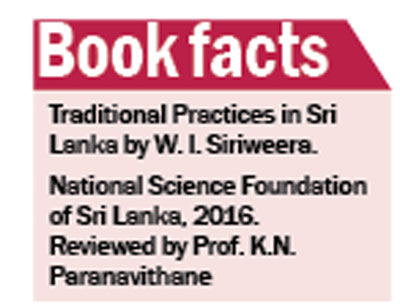Our age-old rituals
View(s):We are now in the age of digitalization. Four to five decades ago in the absence of high-tech equipment, people had to rely much on traditions and practices of their ancestors. Let me begin with one of my own experiences. Brought up in an environment on the banks of Gin-ganga, the river spilled over twice annually during the monsoons, causing havoc and damage to people, property, flora and fauna. Naturally, we were educated on the precautions to take during the floods. Thus, we had no fear of playing in the floodwaters to our hearts’ delight.
Once, I contacted hepatitis turning my skin yellowish. Villagers called it Sengamale, a waterborne disease.During a time when western medical practice was not widespread, with no western medical practitioner or a dispensary in the vicinity, my mother could only feed me with boiled coriander water at regular intervals. A family lived in the village who practised traditional medicine and specialized in treating hepatitis, by the application of the oil extracted from the seeds of Domba commonly called Alexandrian laurel ball tree (calophylliuminophyllum). Domba seeds were available in plenty during the fruiting season. Volunteers collected the fruit (the ball nut) a round, green drupe and brought them to the native medical practitioner’s house to extract the oil. The seeds when passed through a contraption made of two wooden rollers and operated manually would squeeze the juice out of the kernels and was used to extract Domba Oil from the juice so collected. A small quantity of Domba oil applied regularly on the stomach and  rubbed gently for several days the ailment disappears and the body returned to normal.
Similar traditional practices are handed down to us from generation to generation. However, these processes invariably changed over the years, but their core value appears to have remained universal. Before the introduction of writing, these age-old practices were passed on from generation to generation, orally and by continuous practices. All such activities subsequently became a subject called ‚Äėculture‚Äô in the broader sense.
The term ‚Äėculture‚Äôconsists of two main streams namely, tangible and intangible. The traditions and practices of human beings are enshrined in their minds, thus they are intangible. Modern technological innovations overshadow this part of the culture and it is therefore essential that these traditions and practices are preserved for posterity.
What Prof. W. I. Siriweera has attempted in his work ‚ÄėTraditional Practices in Sri Lanka‚Äô (second print) is to record the interesting and useful information relating to traditional agriculture, animal husbandry, irrigation, marine and inland fisheries.
The book addresses five major areas mentioned herein¬† that are most relevant to the day-to-day life in Sri Lanka. It contains interesting extant traditions and practices up to recent times and some even up to now. The ‚Äėkem‚Äô¬† tradition, especially in the agricultural practices plays a major role in protecting harvest. Elaborating on kem rituals associated with agriculture,the author states that, ‚ÄúThe most elaborate rituals connected with paddy cultivation were performed in the threshing floor. Before bringing the paddy for threshing, a pit about three feet deep by half feet wide diameter is dug, to deposit various items to protect the harvest from unseen forces or spirits. These spirits are called Bahirava in Sinhala and Kuli in Tamil. Items such as betel, arecanut, coconut, a bronze plate in which charms (Mantra) have been written, a piece of turmeric, a piece of Kohomba wood, a piece of iron, bronze coins, sea shells, leaves of trees such as Divikaduru (Rejonadichotama), Nika (Vitedxnegundo) Bo (Ficus religiosa) and Iluk (Imperata cylindrical) a small round stone (arakgala) along with some ears of paddy were then placed in the pit. The placing of these items in the pit were undertaken at an auspicious time‚ÄĚ (p. 42). These practices are environmentally friendly and harmless to the human beings extant even today.
Prof. Siriweera referring to Kiri Itirima,explains it as ‚Äėa ceremony of boiling milk performed after each harvest on a morning of a Wednesday or Saturday considered to be the kemmura days, best suited to appease deities. The objective is the protection and well-being of reservoirs, crops, cattle, etc. The five deities whose blessings are invoked are Aiyanayaka, Kambili, Ilandari, Puduressa, and Kadugath Bandra. Every family in the village contributes rice for Kiribath and some families contribute milk as well.The ritual is performed under a lactiferous tree near a paddy field or the reservoir. A thatched shed is temporarily built in the venue and its roof is covered with a white cloth. The milk rice is cooked inside this shed in a large pot called raja heliya. Another small hut mal pela is constructed nearby to place the accoutrements of deities obtained from the village temple. While food is cooked the ceremonially attired kapurala‚Äď the main actor in the rituals ‚Äď prays and appeals to deities amidst drumming. Once the milk rice is cooked, it is offered to deities first along with other offerings such as betel leaves (Piper betel) and thereafter the villagers consume kiribath and disperse.‚Ä̬† (p. 94-5)
The author deserves a handsome compliment for his praiseworthy efforts to gather all possible information and condense it into five chapters. He has been successful in presenting the reader with a useful combination of tradition and culture through his work. Sri Lanka needs more works of this nature to highlight the rich heritage of her traditions.


